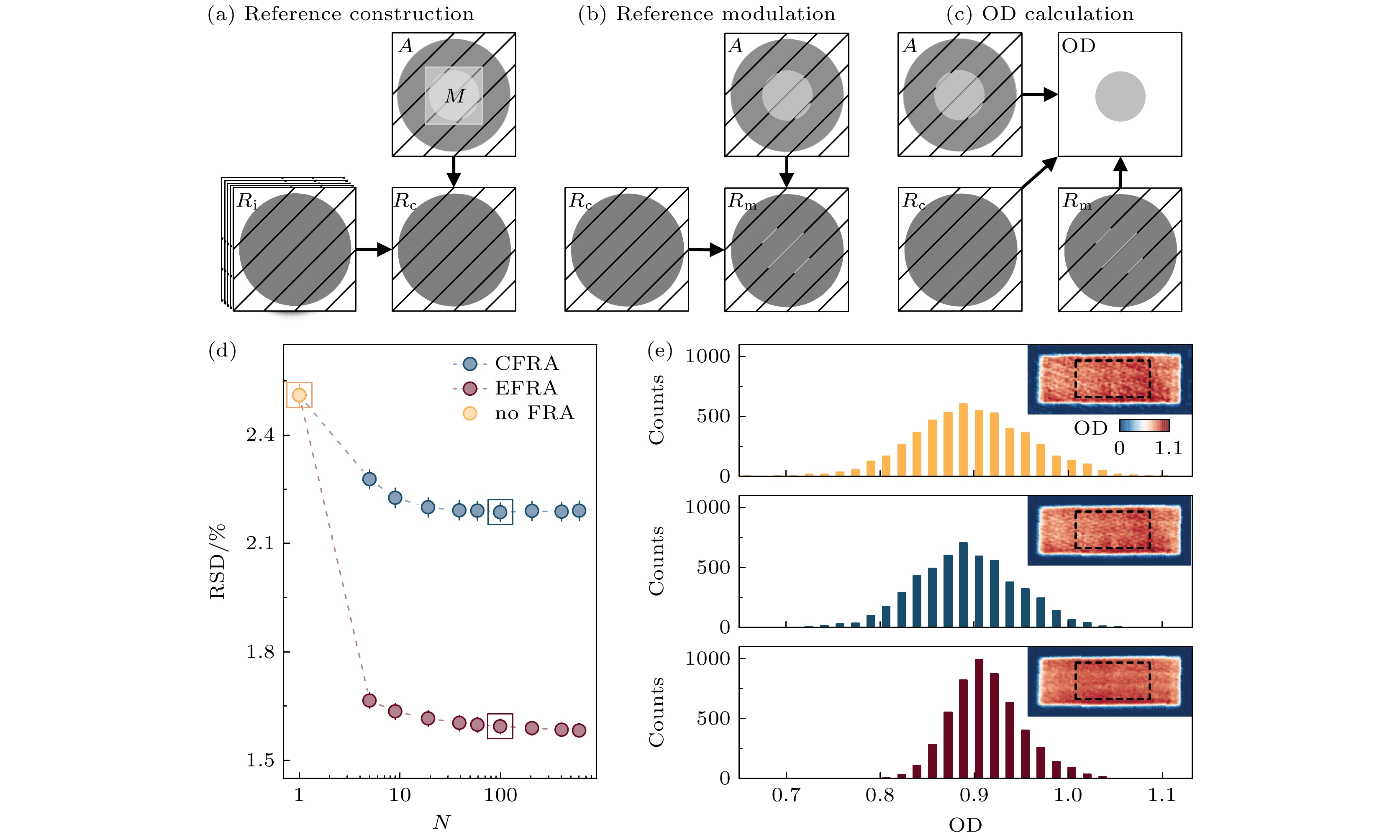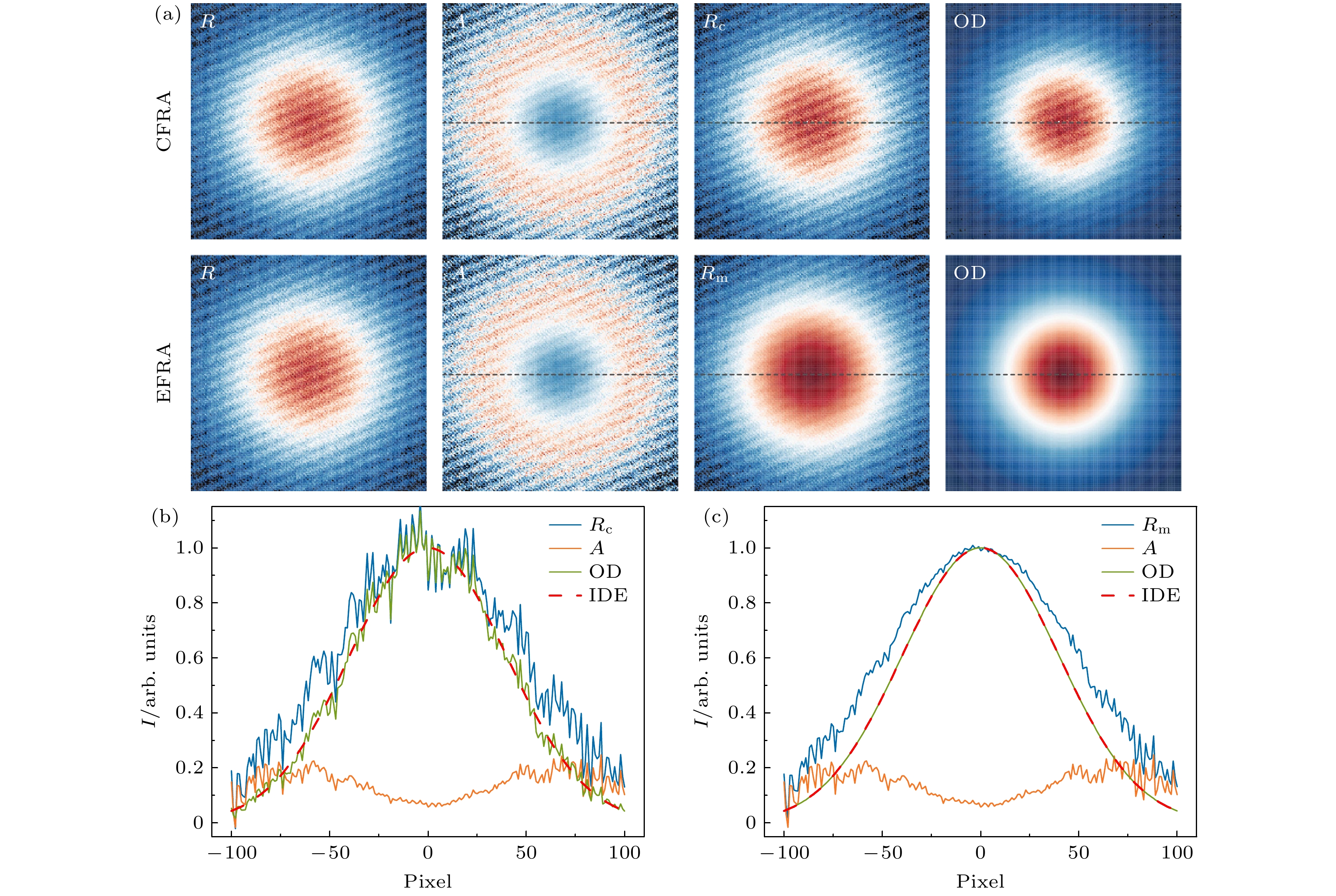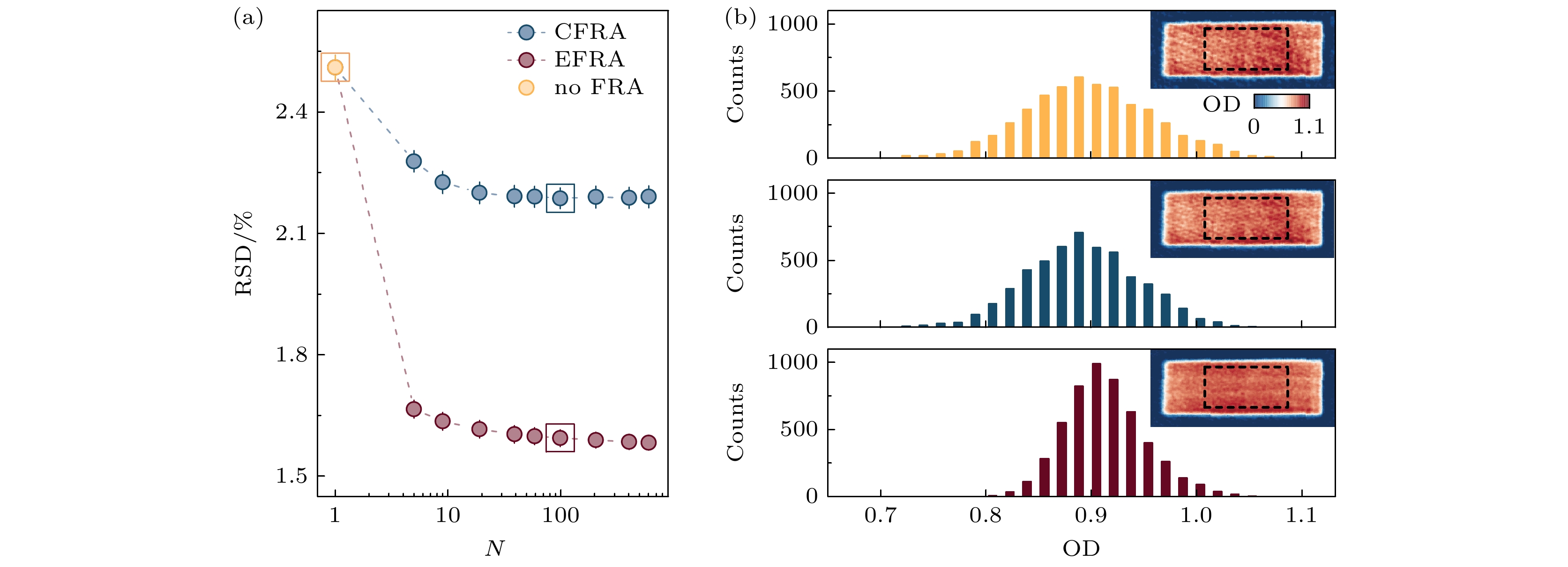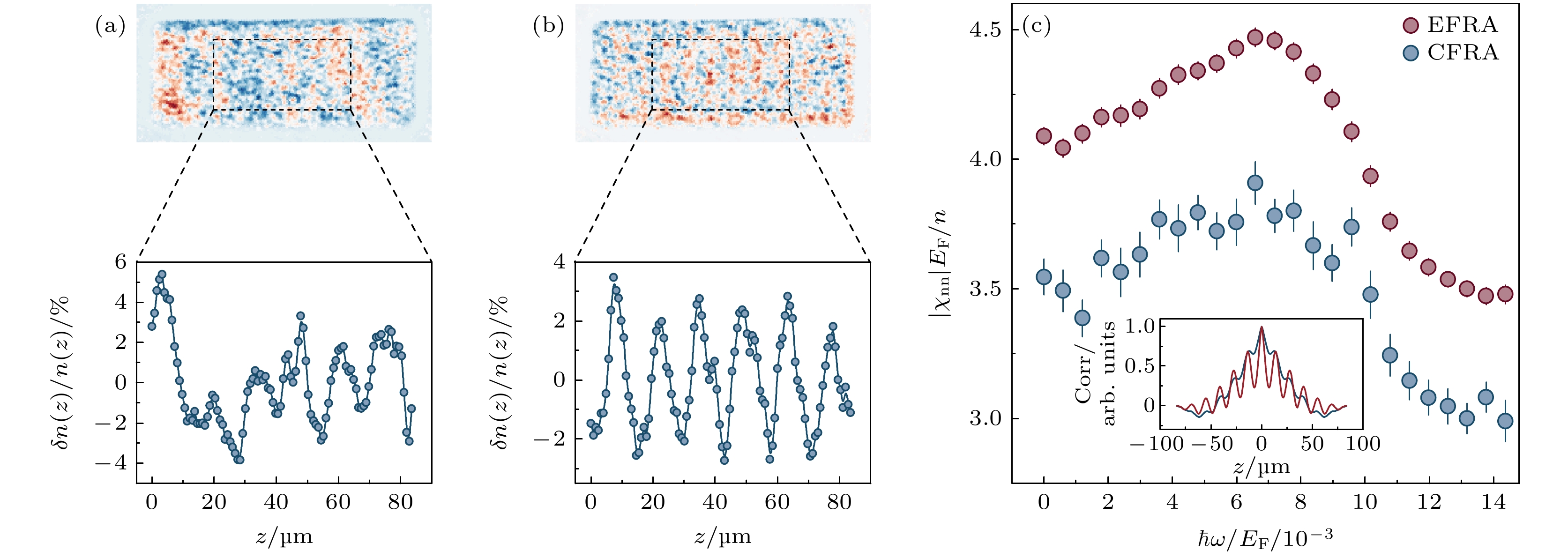-
Absorption imaging is the foundation for quantitative measurements in experiments on ultracold atoms. This technique mainly involves capturing images of both the probing light field and the atom absorption light field. In this process, the unavoidable jitter of the probing light introduces imaging noise of fringe patterns into the atomic optical density distribution OD. In conventional fringe removal algorithms, this type of noise can be normalized by constructing an optimal reference image from multiple reference images that have been actually taken, which shares similar fringe patterns to an absorption image (Fig. (a)). Although this method works well in the region without atomic signal, they often overlook the modulation of the noise signal due to atomic absorption effects, leading to persistent residual fringes on the atom clouds. This problem becomes more pronounced with atomic density increasing. Here, we propose an enhanced fringe removal algorithm that takes into account the effects of atomic absorption, and actively modulates the intensity of the noise signal in the reference image constructed by conventional fringe removal algorithms (Fig. (b)), effectively preventing the residual fringes from forming, thus significantly improving the signal-to-noise ratio of the atomic images. When applied to the absorption imaging of homogeneous Fermi gases with high density, as shown in Fig. (d), this new algorithm successfully reduces the relative standard deviation of optical depth characterizing atomic density fluctuations by approximately 37%, which is about 3 times the relative standard deviation by conventional algorithm. Three subgraphs in Fig. (e) show the optical depth distribution at corresponding data points labeled by square boxes in Fig. (d). Furthermore, we also use this technique to quantitatively determine the second sound in the unitary Fermi superfluid of 6Li atoms. Compared with conventional fringe removal methods, our new algorithm increases the correlation function’s contrast of the density wave nearly 4 times, therefore enhancing the intensity of the density response spectrum by approximately 15% with half the measured standard error, paving the way for quantitatively determining the speed and attenuation of the second sound. These results demonstrate that the enhanced fringe removal algorithm not only effectively suppresses fringe noise, but also facilitates the identification and detection of important physical phenomena in high-density atomic systems, such as some collective excitations and new quantum phases.
-
Keywords:
- fringe removal /
- absorption imaging /
- unitary Fermi gases /
- second sound
[1] Bloch I, Dalibard J, Zwerger W 2008 Rev. Mod. Phys. 80 885
 Google Scholar
Google Scholar
[2] Bloch I, Dalibard J, Nascimbène S 2012 Nat. Phys. 8 267
 Google Scholar
Google Scholar
[3] Cronin A D, Schmiedmayer J, Pritchard D E 2009 Rev. Mod. Phys. 81 1051
 Google Scholar
Google Scholar
[4] Ludlow A D, Boyd M M, Ye J, Peik E, Schmidt P 2015 Rev. Mod. Phys. 87 637
 Google Scholar
Google Scholar
[5] Sirovich L, Kirby M 1987 J. Opt. Soc. Am. A 4 519
 Google Scholar
Google Scholar
[6] Lafreniere D, Marois C, Doyon R, Nadeau D, Artigau E 2007 Astrophys. J. Lett. 660 770
 Google Scholar
Google Scholar
[7] Li X L, Ke M, Yan B, Wang Y Z 2007 Chin. Opt. Lett. 5 128
[8] Ockeloen C F, Tauschinsky A F, Spreeuw R J C, Whitlock S 2010 Phys. Rev. A 82 061606
 Google Scholar
Google Scholar
[9] Niu L X, Guo X X, Zhan Y, Chen X Z, Liu W M, Zhou X J 2018 Appl. Phys. Lett. 113 144103
 Google Scholar
Google Scholar
[10] Segal S R, Diot Q, Cornell E A, Zozulya A A, Anderson D Z 2010 Phys. Rev. A 81 053601
 Google Scholar
Google Scholar
[11] Song B, He C D, Ren Z J, Zhao E T, Lee J, Jo G B 2020 Phys. Rev. Appl. 14 034006
 Google Scholar
Google Scholar
[12] Gaunt A L, Schmidutz T F, Gotlibovych I, Smith R P, Hadzibabic Z 2013 Phys. Rev. Lett. 110 200406
 Google Scholar
Google Scholar
[13] Mukherjee B, Yan Z, Patel P B, Hadzibabic Z, Yefsah T, Struck J, Zwierlein M W 2017 Phys. Rev. Lett. 118 123401
 Google Scholar
Google Scholar
[14] Reinaudi G, Lahaye T, Wang Z, Guéry-Odelin D 2007 Opt. Lett. 32 3143
 Google Scholar
Google Scholar
[15] Hueck K, Luick N, Sobirey L, Siegl J, Lompe T, Moritz H, Clark L W, Chin C 2017 Opt. Express 25 8670
 Google Scholar
Google Scholar
[16] Horikoshi M, Ito A, Ikemachi T, Aratake Y, Kuwata-Gonokami M, Koashi M 2017 J. Phys. Soc. Jpn. 86 104301
 Google Scholar
Google Scholar
[17] Li X, Luo X, Wang S, Xie K, Liu X P, Hu H, Chen Y A, Yao X C, Pan J W 2022 Science 375 528
 Google Scholar
Google Scholar
[18] Landau L 1941 Phys. Rev. 60 356
 Google Scholar
Google Scholar
[19] Donnelly R J 2009 Phys. Today 62 34
 Google Scholar
Google Scholar
[20] Patel P B, Yan Z, Mukherjee B, Fletcher R J, Struck J, Zwierlein M W 2020 Science 370 1222
 Google Scholar
Google Scholar
[21] Hoffmann D K, Singh V P, Paintner T, Jäger M, Limmer W, Mathey L, Hecker Denschlag J 2021 Nat. Commun. 12 7074
 Google Scholar
Google Scholar
[22] Yan Z, Patel P B, Mukherjee B, Vale C J, Fletcher R J, Zwierlein M W 2024 Science 383 629
 Google Scholar
Google Scholar
[23] Kadanoff L P, Martin P C 1963 Ann. Phys. New York. 24 419
 Google Scholar
Google Scholar
[24] Hohenberg P, Martin P 1965 Ann. Phys. New York. 34 291
 Google Scholar
Google Scholar
[25] Hu H, Zou P, Liu X J 2018 Phys. Rev. A 97 023615
 Google Scholar
Google Scholar
[26] Li X, Wang S, Luo X, Zhou Y Y, Xie K, Shen H C, Nie Y Z, Chen Q, Hu H, Chen Y A, Yao X C, Pan J W 2024 Nature 626 288
 Google Scholar
Google Scholar
[27] Yefsah T, Sommer A T, Ku M J H, Cheuk L W, Ji W, Bakr W S, Zwierlein M W 2013 Nature 499 426
 Google Scholar
Google Scholar
[28] Zwierlein M W, Abo-Shaeer J R, Schirotzek A, Schunck C H, Ketterle W 2005 Nature 435 1047
 Google Scholar
Google Scholar
[29] Kadau H, Schmitt M, Wenzel M, Wink C, Maier T, Ferrier-Barbut I, Pfau T 2016 Nature 530 194
 Google Scholar
Google Scholar
[30] Norcia M A, Politi C, Klaus L, Poli E, Sohmen M, Mark M J, Bisset R N, Santos L, Ferlaino F 2021 Nature 596 357
 Google Scholar
Google Scholar
-
图 1 增强条纹去除算法流程图 (a) 通过参考光照片集Ri重构出与原子吸收照片A 在掩膜区M外具有相同条纹特征的参考照片Rc; (b) 根据A和Rc构建调制参考光照片Rm; (c) 使用Rc, Rm 以及A计算原子光学深度分布 OD = ln (Rc/A) + (Rm – A)/(χst), 图中的倾斜线表示条纹噪声
Figure 1. Schematic of the enhanced fringe removal process: (a) The construction of light reference image Rc which shares a similar fringe feature with the atom image A outside the mask using light reference image set Ri; (b) the construction of modulated light reference image Rm using A and Rc; (c) the calculation of the optical depth distribution OD = ln (Rc/A) + (Rm – A)/(χst) from A, Rc and Rm. The inclined lines in the figure represent the fringe pattern.
图 2 超饱和吸收成像下两种算法的数值结果对比 (a) CFRA算法(第一行)和EFRA算法(第二行)下的参考光照片R、原子吸收照片A、重构照片Rc和Rm、以及原子光学深度分布OD; (b), (c) 分别为 (a) 图中CFRA算法和EFRA算法下图像灰色虚线处的截面分布图, 其中红色虚线代表理想状态下原子光学深度的截面分布
Figure 2. The numerical comparison of two algorithms under saturated absorption imaging: (a) The light reference images R, atom absorption images A, reconstructed reference images Rc and Rm, and optical depth distributions in CFRA (the first row) and EFRA (the second row); (b), (c) exhibit cross section distributions at the gray dashed lines of the images under two algorithms in (a), and the red dashed line represents the distribution under ideal conditions.
图 3 条纹去除效果 (a)相对标准偏差RSD随参考光照片集大小的变化关系; (b)三幅子图展示了(a)中方框内相应数据点处原子的光学深度照片, 以及虚线框(84.40 μm × 41.39 μm)内光学深度的分布直方图
Figure 3. Fringe removal performance: (a) The relative standard error as a function of the size of light reference image set under different algorithms; (b) the three subgraphs show the optical depth distribution at corresponding data points labeled by square boxes in (a), and the histograms of the optical depth in the dashed box (84.40 μm × 41.39 μm).
图 4 不同算法下密度响应谱的提取 (a) CFRA算法和 (b) EFRA算法下幺正费米超流内第二声波的密度响应差分图, 第一行为二维密度波动图像, 第二行为第一行图像虚线框(84.40 μm × 41.39 μm)内积分后沿z方向传播的一维约化密度波动δn(z)/n(z), 其中的曲线为引导线; (c)分别采用两种算法处理后对应于第二声波的密度响应谱, 其中子图为(a), (b)中一维约化密度波动δn(z)/n(z)的关联函数, 图中的误差棒表示1倍标准差
Figure 4. The extraction of density response spectrum under different algorithms. Difference images of the density response induced by the second sound in unitary Fermi superfluid processed by CFRA (a) and EFRA (b), the upper panel shows the two-dimensional density waves, and the lower panel shows the one-dimensional normalized density waves δn(z)/n(z) along the z axis after integrating the difference images in the dashed boxes (84.40 μm×41.39 μm) of the upper panel respectively, and the solid line is a guide to the eye; (c) the density response spectra corresponding to the second sound processed by the two algorithms respectively, and the inset exhibits the correlation functions of δn(z)/n(z) as shown in (a) and (b). The error bars represent one standard deviation.
-
[1] Bloch I, Dalibard J, Zwerger W 2008 Rev. Mod. Phys. 80 885
 Google Scholar
Google Scholar
[2] Bloch I, Dalibard J, Nascimbène S 2012 Nat. Phys. 8 267
 Google Scholar
Google Scholar
[3] Cronin A D, Schmiedmayer J, Pritchard D E 2009 Rev. Mod. Phys. 81 1051
 Google Scholar
Google Scholar
[4] Ludlow A D, Boyd M M, Ye J, Peik E, Schmidt P 2015 Rev. Mod. Phys. 87 637
 Google Scholar
Google Scholar
[5] Sirovich L, Kirby M 1987 J. Opt. Soc. Am. A 4 519
 Google Scholar
Google Scholar
[6] Lafreniere D, Marois C, Doyon R, Nadeau D, Artigau E 2007 Astrophys. J. Lett. 660 770
 Google Scholar
Google Scholar
[7] Li X L, Ke M, Yan B, Wang Y Z 2007 Chin. Opt. Lett. 5 128
[8] Ockeloen C F, Tauschinsky A F, Spreeuw R J C, Whitlock S 2010 Phys. Rev. A 82 061606
 Google Scholar
Google Scholar
[9] Niu L X, Guo X X, Zhan Y, Chen X Z, Liu W M, Zhou X J 2018 Appl. Phys. Lett. 113 144103
 Google Scholar
Google Scholar
[10] Segal S R, Diot Q, Cornell E A, Zozulya A A, Anderson D Z 2010 Phys. Rev. A 81 053601
 Google Scholar
Google Scholar
[11] Song B, He C D, Ren Z J, Zhao E T, Lee J, Jo G B 2020 Phys. Rev. Appl. 14 034006
 Google Scholar
Google Scholar
[12] Gaunt A L, Schmidutz T F, Gotlibovych I, Smith R P, Hadzibabic Z 2013 Phys. Rev. Lett. 110 200406
 Google Scholar
Google Scholar
[13] Mukherjee B, Yan Z, Patel P B, Hadzibabic Z, Yefsah T, Struck J, Zwierlein M W 2017 Phys. Rev. Lett. 118 123401
 Google Scholar
Google Scholar
[14] Reinaudi G, Lahaye T, Wang Z, Guéry-Odelin D 2007 Opt. Lett. 32 3143
 Google Scholar
Google Scholar
[15] Hueck K, Luick N, Sobirey L, Siegl J, Lompe T, Moritz H, Clark L W, Chin C 2017 Opt. Express 25 8670
 Google Scholar
Google Scholar
[16] Horikoshi M, Ito A, Ikemachi T, Aratake Y, Kuwata-Gonokami M, Koashi M 2017 J. Phys. Soc. Jpn. 86 104301
 Google Scholar
Google Scholar
[17] Li X, Luo X, Wang S, Xie K, Liu X P, Hu H, Chen Y A, Yao X C, Pan J W 2022 Science 375 528
 Google Scholar
Google Scholar
[18] Landau L 1941 Phys. Rev. 60 356
 Google Scholar
Google Scholar
[19] Donnelly R J 2009 Phys. Today 62 34
 Google Scholar
Google Scholar
[20] Patel P B, Yan Z, Mukherjee B, Fletcher R J, Struck J, Zwierlein M W 2020 Science 370 1222
 Google Scholar
Google Scholar
[21] Hoffmann D K, Singh V P, Paintner T, Jäger M, Limmer W, Mathey L, Hecker Denschlag J 2021 Nat. Commun. 12 7074
 Google Scholar
Google Scholar
[22] Yan Z, Patel P B, Mukherjee B, Vale C J, Fletcher R J, Zwierlein M W 2024 Science 383 629
 Google Scholar
Google Scholar
[23] Kadanoff L P, Martin P C 1963 Ann. Phys. New York. 24 419
 Google Scholar
Google Scholar
[24] Hohenberg P, Martin P 1965 Ann. Phys. New York. 34 291
 Google Scholar
Google Scholar
[25] Hu H, Zou P, Liu X J 2018 Phys. Rev. A 97 023615
 Google Scholar
Google Scholar
[26] Li X, Wang S, Luo X, Zhou Y Y, Xie K, Shen H C, Nie Y Z, Chen Q, Hu H, Chen Y A, Yao X C, Pan J W 2024 Nature 626 288
 Google Scholar
Google Scholar
[27] Yefsah T, Sommer A T, Ku M J H, Cheuk L W, Ji W, Bakr W S, Zwierlein M W 2013 Nature 499 426
 Google Scholar
Google Scholar
[28] Zwierlein M W, Abo-Shaeer J R, Schirotzek A, Schunck C H, Ketterle W 2005 Nature 435 1047
 Google Scholar
Google Scholar
[29] Kadau H, Schmitt M, Wenzel M, Wink C, Maier T, Ferrier-Barbut I, Pfau T 2016 Nature 530 194
 Google Scholar
Google Scholar
[30] Norcia M A, Politi C, Klaus L, Poli E, Sohmen M, Mark M J, Bisset R N, Santos L, Ferlaino F 2021 Nature 596 357
 Google Scholar
Google Scholar
Catalog
Metrics
- Abstract views: 4961
- PDF Downloads: 178
- Cited By: 0
















 DownLoad:
DownLoad:



